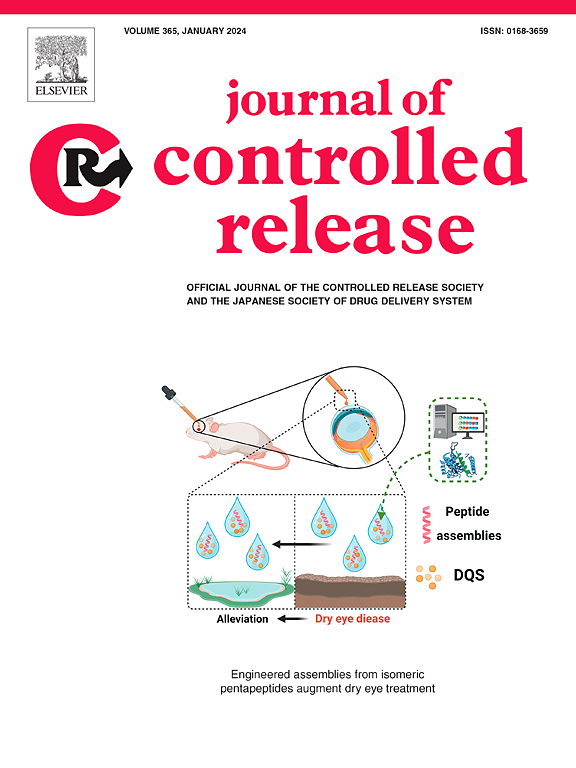COG133肽偶联脂质纳米颗粒使小鼠成神经管细胞瘤对放射治疗敏感
IF 10.5
1区 医学
Q1 CHEMISTRY, MULTIDISCIPLINARY
引用次数: 0
摘要
髓母细胞瘤(MB)是一种恶性脑肿瘤,通常发生在小脑,并有扩散到脊髓或中枢神经系统(CNS)的其他部分的倾向。颅脊髓照射(CSI)长期以来一直是治疗MB的基石,特别是对于高风险或转移性疾病的患者。然而,CSI经常导致长期的神经认知缺陷,包括学习障碍和生长异常,特别是在儿童中。在本研究中,我们旨在通过使用polo样激酶1 (PLK1)特异性抑制剂Volasertib (VSB)来降低照射剂量和MB的增殖。VSB对HDMB03和DAOY细胞的IC50分别为27.43 nM和13 nM。然而,在原位MB小鼠模型中,VSB作为游离药物并没有提高总生存率或减轻肿瘤负担。因此,我们将VSB包裹在cog133共轭脂质纳米颗粒(COG133-LNPs)中,以绕过血脑屏障(BBB)。我们观察到,与非靶向LNPs相比,负载VSB的COG-133-LNPs使VSB在大脑中的生物分布增加了3倍。此外,与VSB或单独放疗相比,COG133-LNPs联合放疗显著降低了肿瘤负荷。根据我们的观察,COG133-LNPs在杀伤MB细胞和使其对放射治疗敏感方面表现出很高的效力。本文章由计算机程序翻译,如有差异,请以英文原文为准。

COG133 peptide-conjugated lipid nanoparticles sensitize medulloblastoma to radiation therapy in mice
Medulloblastoma (MB) is a malignant brain tumor that often arises in the cerebellum and has a propensity for spreading to the spinal cord or other parts of the central nervous system (CNS). Craniospinal irradiation (CSI) has long been a cornerstone in the treatment of MB, especially for patients with high-risk or metastatic disease. However, CSI often leads to long-term neurocognitive deficits, including learning disabilities, and growth abnormalities, especially in children. In this study, we aimed to decrease the dose of irradiation and the proliferation of MB by using Volasertib (VSB), a Polo-like kinase 1 (PLK1) specific inhibitor. VSB was highly potent in-vitro with an IC50 of 27.43 nM and 13 nM in HDMB03 and DAOY cells, respectively. However, in the orthotopic MB mouse model, VSB as a free drug did not improve overall survival or decrease tumor burden. Hence, we encapsulated VSB in COG133-conjugated lipid nanoparticles (COG133-LNPs) to circumvent the blood-brain barrier (BBB). We observed that COG-133-LNPs loaded with VSB increased the biodistribution of VSB by three folds than the non-targeted LNPs in the brain. Furthermore, COG133-LNPs along with irradiation decreased tumor burden significantly as compared to VSB or radiation alone. To our observation, COG133-LNPs display high potency in killing MB cells and sensitizing them toward radiation therapy.
求助全文
通过发布文献求助,成功后即可免费获取论文全文。
去求助
来源期刊

Journal of Controlled Release
医学-化学综合
CiteScore
18.50
自引率
5.60%
发文量
700
审稿时长
39 days
期刊介绍:
The Journal of Controlled Release (JCR) proudly serves as the Official Journal of the Controlled Release Society and the Japan Society of Drug Delivery System.
Dedicated to the broad field of delivery science and technology, JCR publishes high-quality research articles covering drug delivery systems and all facets of formulations. This includes the physicochemical and biological properties of drugs, design and characterization of dosage forms, release mechanisms, in vivo testing, and formulation research and development across pharmaceutical, diagnostic, agricultural, environmental, cosmetic, and food industries.
Priority is given to manuscripts that contribute to the fundamental understanding of principles or demonstrate the advantages of novel technologies in terms of safety and efficacy over current clinical standards. JCR strives to be a leading platform for advancements in delivery science and technology.
 求助内容:
求助内容: 应助结果提醒方式:
应助结果提醒方式:


